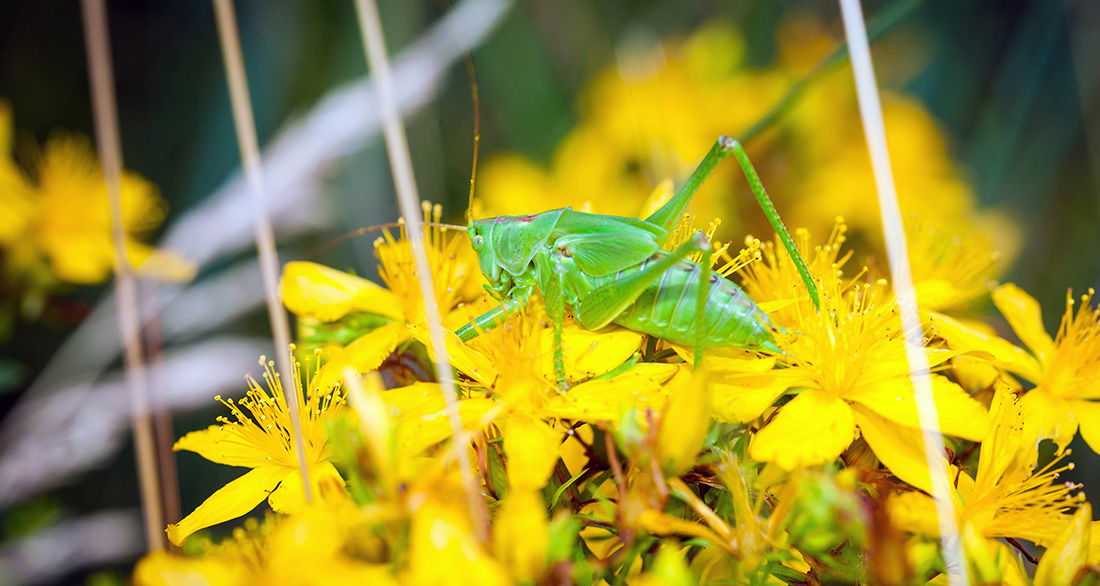Aphids, Mealybugs, Whiteflies and Scale Insects
There are several species of aphids, mealybugs, whiteflies, soft and armored scale insects that become pests of landscape plants where they may be commonly found sucking juices on various parts of the plant. The majority of the species prefer young shoots and leaves. Most plants can sustain moderate numbers of these pests without adverse effects, but high population levels can cause stunted growth, curled and yellowed leaves, or distorted stems and fruit. Populations may build up rapidly, when conditions are favorable, reaching pest proportions. Many sap sucking insects excrete honeydew, a sweet, sticky substance that attracts Argentine ants which are ubiquitous in the LA Basin. The Argentine ants consume the honeydew and in return protect these pests from various natural enemies. A black sooty mold often develops on leaves contaminated by honeydew which blocks light transmission to foliage and affects plant growth. Aphids, whiteflies and mealybugs are also known to transmit several destructive plant viruses.
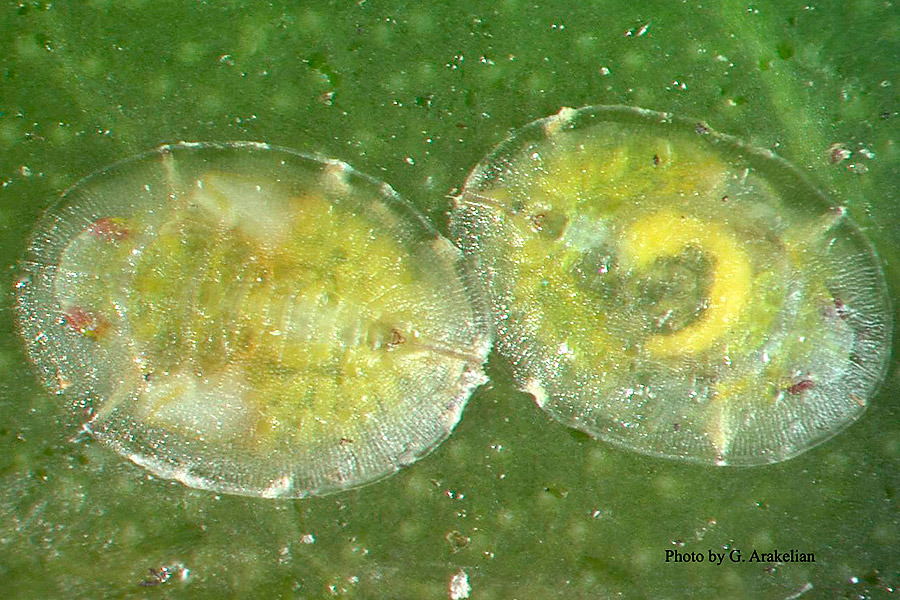
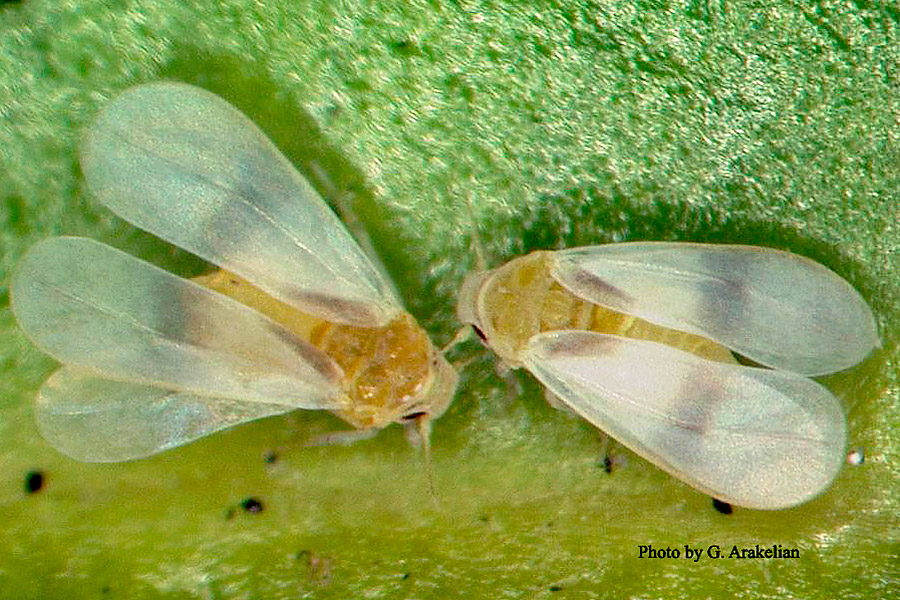
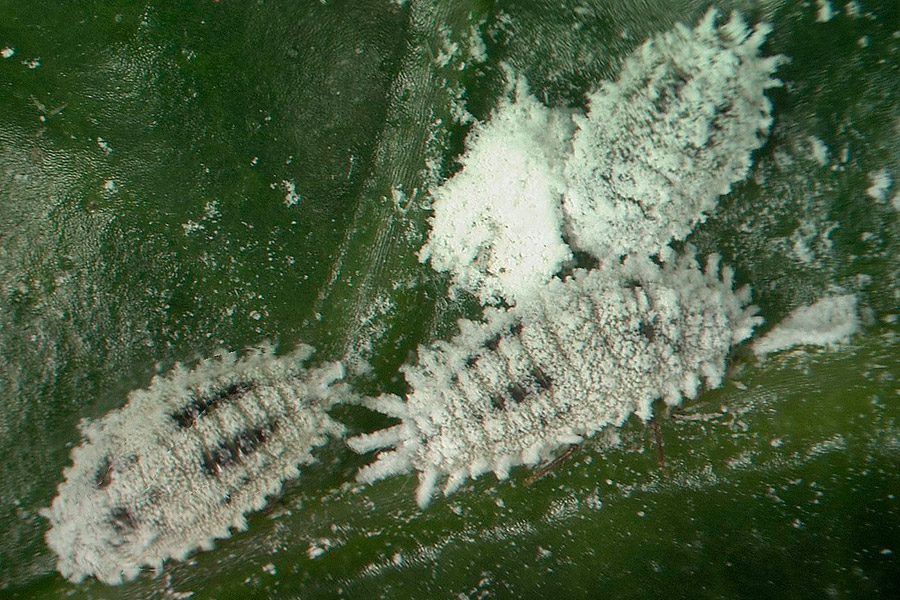
Several factors may boost the sap sucking pest numbers on landscape plants: environmental stress due to overwatering or underwatering, fertilization with high rates of nitrogen fertilizer, or frequent pruning that promotes quick succulent growth.
Many different pest species can occur in Los Angeles County, including brown soft scale (Coccus hesperidum), nigra scale (Parasaissetia nigra), hemispherical scale (Saissetia coffeae), barnacle scale (Ceroplastes cirripediformis), latania scale (Hemiberlesia lataniae), boisduval scale (Diaspis boisduvalii), oleander scale (Aspidiotus nerii), citrus mealybug (Planococcus citri), longtailed mealybug (Pseudococcus longispinus), obscure mealybug (P. viburni), pineapple mealybug (Dysmicoccus brevipes), coconut mealybug (Nipaecoccus nipae), wooly whitefly (Aleurothrixus floccosus), giant whitefly (Aleurodicus digesii), mulberry whitefly (Tetraleurodes mori), sweet potato whitefly (Bemisia tabaci), crown whitefly (Aleuroplatus coronata), ash whitefly (Siphoninus phillyreae), spirea aphid (Aphis spiraecola), oleander aphid (A. nerii), melon aphid (A. gossypii), conifer aphids (Cinara spp.) and green peach aphid (Myzus persicae), and others.
There are many parasites and predators of aphids, mealybugs, whiteflies, and scale insects. These pests often are well controlled by ladybird beetles, lacewings, minute pirate bugs, bigeyed bugs, parasitic wasps, and predatory flies. Parasites and predators do not eliminate these pests, but rather keep populations at a level where they do not cause significant damage. Use TANGLEFOOT® or other sticky barrier to keep Argentine ants off trees and shrubs, and trim all branches touching the ground. Wash dirt and dust (detrimental for natural enemies) from infested plants. Yellow sticky cards placed near problem area may help trap large numbers of whiteflies and aphids that are attracted to the yellow color.
Neem oil, narrow-range oil or insecticidal soap can be used to control aphids, mealybugs, whiteflies, and scale insects. Their low residual effects allow natural enemies to move in and establish shortly after the treatment. Broad spectrum contact insecticides should be used only in those limited parts of the plant where sap sucking insects are abundant in order to preserve natural enemies. Systemic insecticides are preferable (they help conserve parasites and predators) and often are relatively more effective than contacts.
Psyllids
Psyllids can be found on wide range of plants and tend to be relatively specific in their hosts, often attacking a single species, genus or family of plants. Saliva injected during feeding process may distort the foliage, turn it yellow and can stunt the growth of the plant. Psyllids may also induce galls on leaves and transmit injurious plant pathogens. Many psyllid species produce large amounts of honeydew and their nymphs can excrete waxy secretions or form wax caps (lerps) of various shapes over their bodies.
Several psyllids are well known to Los Angeles County residents, including Asian citrus psyllid (Diaphorina citri), eugenia psyllid (Trioza eugenii), redgum lerp psyllid (Glycaspis brimblecombei), bluegum psyllid (Ctenarytaina eucalypti), spotted gum lerp psyllid (Eucalyptolyma maideni), and pepper tree psyllid (Calophya schini).
Control measures are similar to that of aphids, mealybugs, whiteflies and scale insects mentioned above.
Leafhoppers, Planthoppers and Treehoppers
Leafhoppers, planthoppers and treehoppers are active, mobile insects attacking various plant groups. They suck the plant sap often leaving white flecking on the foliage and curled leaves. Some species produce honeydew on which sooty mold grows. Several pest species are important vectors of plant pathogens that cause various injurious diseases.
The following species are the most commonly encountered pests in Los Angeles County: glassy-winged sharpshooter (Homalodisca vitripennis), smoketree sharpshooter (H. liturata), blue-green sharpshooter (Graphocephala atropunctata), two-spotted leafhopper (Sophonia rufofascia), keelbacked treehopper (Antianthe expansa), oak treehopper (Platycotis vittata), buffalo treehopper (Stictocephala bisonica) and torpedo bug (Siphanta acuta).
Control of leafhoppers, planthoppers and treehoppers is often problematic. Management of weeds (that may harbor large populations of these pests) around landscaped areas is important. Screening of individual plants with various physical barriers (floating row covers, plant cages, etc.) can also be helpful. Many egg parasites, naturally occurring in the environment, provide some control of these pests. Broad spectrum contact insecticides should be used with caution to preserve these natural enemies.
Thrips
Thrips are relatively minute (very tiny) insects that injure plants by puncturing the leaves and sucking the released sap. Damaged leaves display stippling, expanded silvery spots and are often shriveled. Some species may induce galls (leaf folds) which create a safe environment for adults to deposit their eggs and immatures to develop. Heavy infestations may retard the growth and lead to defoliation of the host plant. Thrips are known to transmit several injurious plant pathogens.
Our local species include: Cuban laurel thrips (Gynaikothrips ficorum), myoporum thrips (Klambothrips myopori), western flower thrips (Frankliniella occidentalis), and onion thrips (Thrips tabaci).
Controlling thrips often presents certain difficulties. Management should include conservation/augmentation of natural enemies, proper cultural practices and insecticides. If insecticides are used, low toxicity, narrow spectrum and short duration products should be selected to avoid harming natural predators.
Grasshoppers and Katydids
Grasshoppers and katydids consume a wide variety of plant materials. They attack plants leaving holes and notched edges on leaves or create scarring and distortion of developing fruit. Large populations of grasshoppers, often building up around foothills and empty lots (especially during certain years with moist and warm springtime conditions), can occasionally cause some measurable damage in nearby landscaped areas.
Among most noteworthy local species are devastating grasshopper (Melanoplus devastator), gray bird grasshopper (Schistocerca nitens), pallid-winged grasshopper (Trimerotropis pallidipennis), chaparral katydid (Platylyra californica), angle-winged katydids (Microcentrum spp.), and bush katydids (Scudderia spp.).
Controlling grasshoppers and katydids may present some challenges. Pesticide treatments of weedy areas adjacent to gardens early in the season when these pests are in their immature stages may give adequate control. Using various baits containing insecticides around the perimeter of landscaped areas can be helpful too. Individual plants can be protected with various physical barriers such as plant cages and plastic covers similar to the floating row covers used in agriculture.
Ants
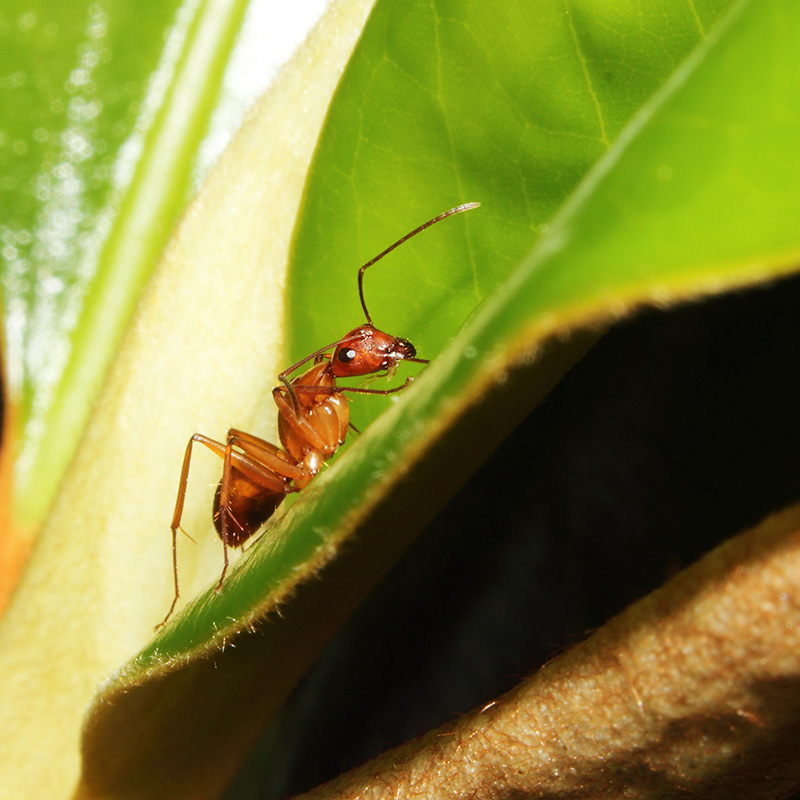 Ants are among the most commonly encountered insects in landscaped areas. They have a wide range in habits and their impact on cultivated areas can be highly variable. Only a handful of ant species directly damage plants. Many ant species feed on other insects and are beneficial predators attacking and eliminating plant pests. Others gather and consume seeds or tend aphids, mealybugs, whiteflies and soft scales harvesting sweet liquids (”honeydew”) they produce and protecting these pests from attacks of predators and parasites. At the same time, some ant species may create serious nuisance and health problems by inflicting painful bites or stings.
Ants are among the most commonly encountered insects in landscaped areas. They have a wide range in habits and their impact on cultivated areas can be highly variable. Only a handful of ant species directly damage plants. Many ant species feed on other insects and are beneficial predators attacking and eliminating plant pests. Others gather and consume seeds or tend aphids, mealybugs, whiteflies and soft scales harvesting sweet liquids (”honeydew”) they produce and protecting these pests from attacks of predators and parasites. At the same time, some ant species may create serious nuisance and health problems by inflicting painful bites or stings.
The most notable and common ant species in Los Angeles County are carpenter ants (Camponotus spp.), Argentine ants (Linepithema humile), bigheaded ants (Pheidole spp.), California harvester ants (Pogonomyrmex californicus), field ants (Formica spp.), pyramid ants (Dorymyrmex spp.), red imported fire ants (Solenopsis invicta), southern fire ants (Solenopsis xyloni), and velvety tree ants (Liometopum occidentale).
Ant control often needs application of several integrated pest management methods and also perseverance. It is particularly important in situations where ants are associated with honeydew producing insect pests. Excluding ants from trees and shrubs is often sufficient for reestablishing successful biological control of various plant sucking insects. Trimming branches that touch the ground and banding plants with special sticky substances (such as Tanglefoot®) will keep ants from climbing up the trunk.
Several solid and liquid ant baits are available and contain insecticides along with food attractant (protein or carbohydrate based). They are more selective and effective in controlling ants than contact insecticides. Ant bait products must be slow acting to allow enough time for workers to reach the nest before they are killed and share it with their nestmates.
Arachnids (Mites)
Plant feeding mites are often very tiny, slow moving creatures that are hard to detect. Although they bear a superficial resemblance to insects, they are actually arachnids and, therefore, more closely related to spiders. Most pest mite species feed on plant foliage often stippling and shriveling leaves. Some mites attack the bark of woody plants, form extensive webbing around their congregation sites or induce galls where they seek protection. At the same time, mites are known to transmit several plant diseases. Low population levels are often tolerable for some plants and may remain unnoticed, but heavy infestations commonly lead to severe plant damage.
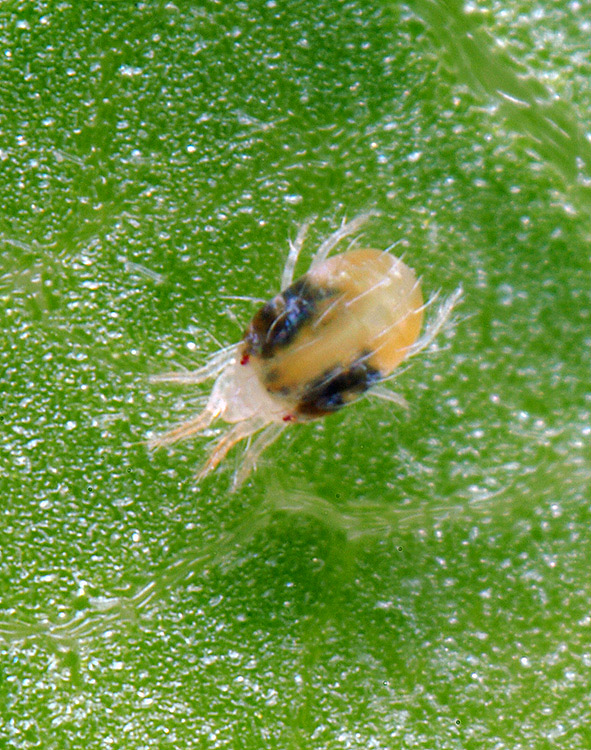
Among other things, the eight legs on this two-spotted spider mite identify it as an arachnid and not an insect. (Photo credit J. Holopainen [Creative Commons])
The following are a few notable examples of local plant feeding mites: twospotted spider mite (Tetranychus urticae), pacific spider mite (Tetranychus pacificus), persea mite (Oligonychus perseae), sixspotted mite (Eotetranychus sexmaculatus), citrus bud mite (Eriophyes sheldoni), and European red mite (Panonychus ulmi).
There are numerous predators that feed on plant feeding mites and limit their populations. Some species are even commercially available in California. Any chemical control measures used against pest mites should also address the conservation and monitoring of beneficial predatory invertebrates essential for their management. Use of the broad spectrum pesticides can actually cause mite outbreaks and should be avoided if possible. Insecticidal soaps and oils are often more effective for mite control and are least toxic to environment. Many plant feeding mites prefer dusty, hot locations and are commonly found in landscaped areas adjacent to unpaved roads and empty, dry lots. Plants growing in these conditions should have proper irrigation and can be periodically washed with strong water pressure. This latter measure will also create an environment that is favorable for predators of mites.
Mollusks (Snails and slugs)
Snails and slugs are well known landscape pests that mostly feed at night. The feeding injury and the slime trail are commonly noticed before the pest is detected. Snails and slugs feed on a variety of living and decaying plant material. They often attack foliage leaving irregularly shaped holes that have smooth edges. Young seedlings are particularly vulnerable.
Population numbers are particularly large in cool, moist, well-watered environments. During long dry spells, snails and slugs seek shelters. Snails may seal themselves and keep attached on various solid objects until conditions become more favorable.
Among the most common mollusks of Los Angeles County are brown garden snail (Cornu aspersum), banded slug (Lehmannia valentiana), tawny garden slug (Limacus flavus), gray garden slug (Deroceras reticulatum), and greenhouse slug (Milax gagates).
Control measures are necessary if new seedlings have been planted or when excessive plant damage was observed. Elimination of hiding places of snails and slugs (stones, weeds, ground covers, wood piles etc.), handpicking and controlling excessive watering (switching to drip irrigation) may noticeably reduce their numbers. Several effective bait products and copper barriers are available for combating snails and slugs. Ground beetles (Scaphinotus spp.), devil’s coach horse beetle (Ocypus olens), and many birds and mammals are well known natural enemies of snails and slugs. Additionally, predatory decollate snails (Rumina decollata) can be purchased and released in Los Angeles County to manage brown garden snail populations.


